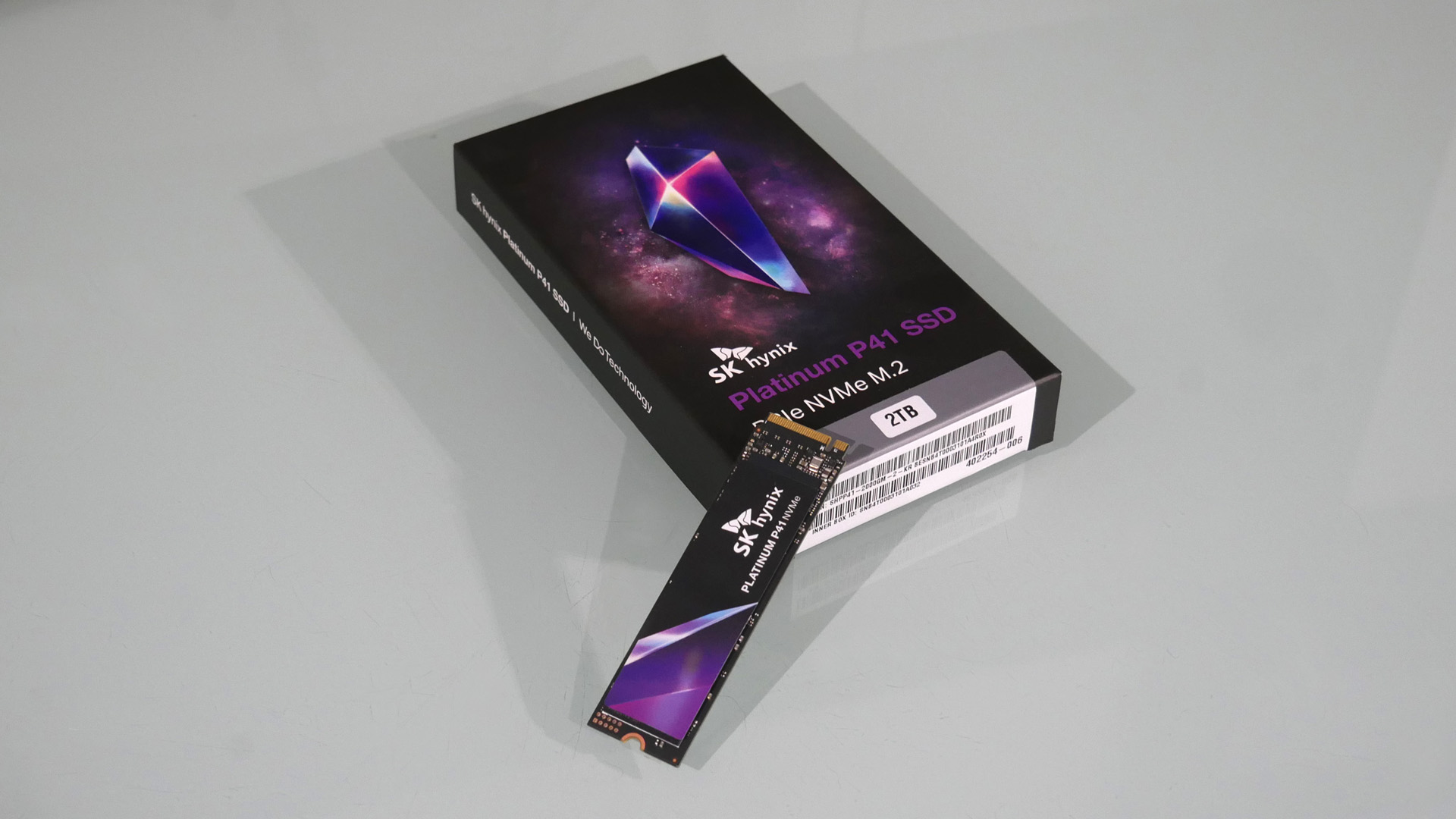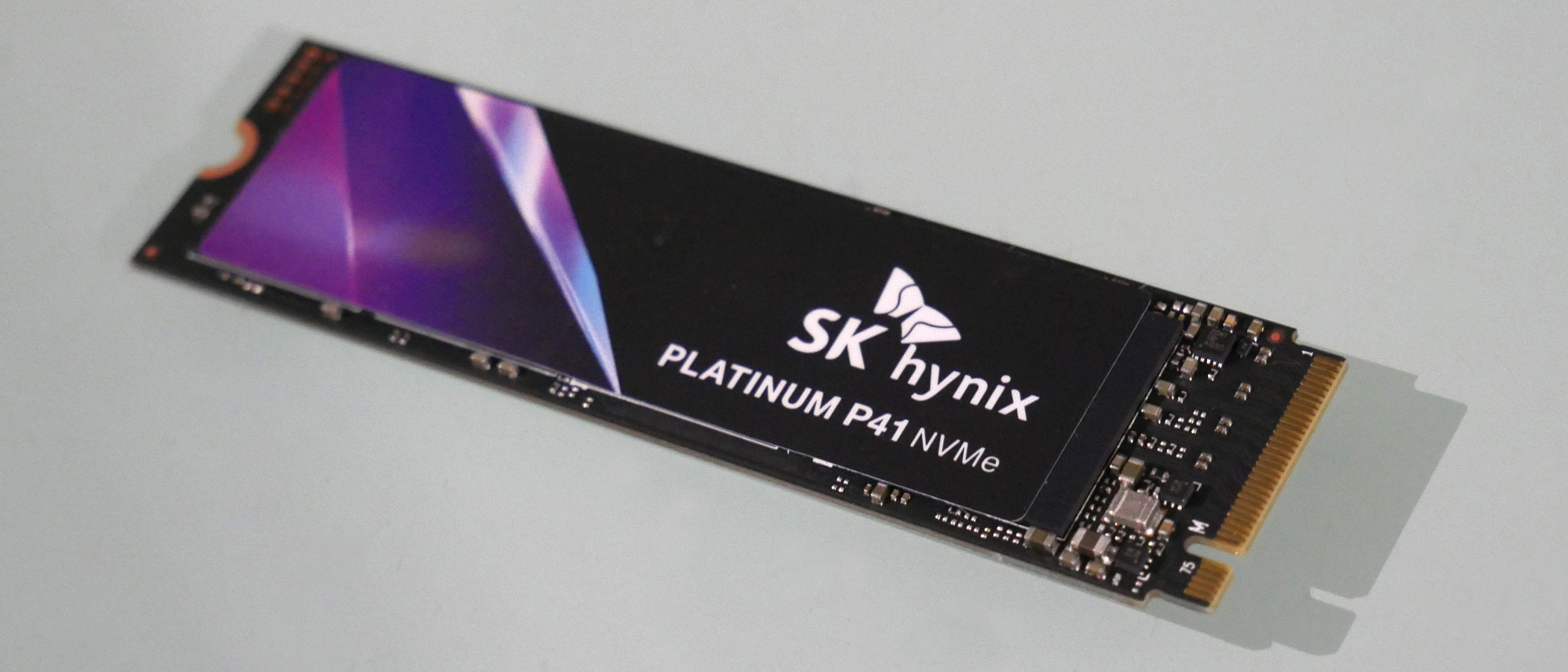GamesRadar+ Verdict
The SK Hynix Platinum P41 SSD takes on the big boys in the SSD market and largely holds its own: it's a very quick Gen 4 M.2 SSD at an attractive price. You just have to watch those operating temperatures…
Pros
- +
Great specs and performance
- +
Low latency for a NAND drive
- +
Competitive pricing
Cons
- -
Runs a little hot for consoles
- -
Not actually a game changer
Why you can trust GamesRadar+
The new SK Hynix Platinum P41 is aimed squarely at the very best high-performance M.2 SSDs for gaming. That’s novel for an SK Hynix drive. But it shouldn’t actually be a surprise. SK Hynix isn’t all that well known as a consumer brand. But it is absolutely one of the heavyweights when it comes to making the bits that go into SSDs, like flash memory chips.
As it happens, SK Hynix has just snapped up Intel’s entire SSD business (minus the exotic Optane bit, which is simply being shuttered entirely). So it’s about to be an even bigger noise in SSDs. Enter, therefore, this new high-performance M.2 drive. It’s right at the cutting edge of currently available tech. Which means it’s based on a quad-lane PCIe Gen 4 interface. Gen 5 drives and the PC and console platforms required to support them are still a little ways out.
The P41 (our review unit was the 2TB version) also sports a new, much upgraded SK Hynix in-house controller chip, plenty of DDR cache memory, the latest 176-layer TLC NAND memory and all-round specs look at least as good as established players in the performance M.2 market, like the Samsung 980 Pro or WD Black SN850. While the P41 is, in theory, compatible with both PC and the latest Microsoft and Sony consoles, this first iteration of the P41 probably makes more sense as a performance PC drive. More on that in a moment.
Design & Features
Design-wise, there ain’t much to see here. The SK Hynix Platinum P41 2TB is a single-sided M.2 drive with no heatsink or spreader. For PC, that’s fine, possibly even preferable given that many premium motherboards provide SSD cooling. For the console, it’s more of a potential issue. Again, hold that thought.
Specs-wise, the SK Hynix Platinum P41 2TB gets the aforementioned upgrade to PCIe Gen 4 support over the existing SK Hynix Gold P31, which was a Gen 3 drive. What’s more, the new P41 also sports a new controller chip, known as the SK Hynix Aries. It doesn’t just upgrade the drive’s PCIe spec. It also doubles the memory channel count from four to eight, which is required to compete with the fastest M.2 drives. The Aries chip also has double the cores of SK Hynix’s previous controller plus 2GB of DDR4 cache memory. Nice.
When it comes to the actual flash memory chips, the P41 has SK Hynix’s latest and greatest 176-layer 3D TLC NAND. SK Hynix reckons it’s roughly 40 percent faster than its older 128-layer tech. In terms of claimed performance, you’re looking at 7,000MB/s sequential reads and 6,500MB/s writes for this 2TB model. Smaller versions of the drive have slightly slower write performance.
Of course, most Gen 4 drives claim similar write performance. If anything, then, random access or IOPS performance is where a drive can really make a difference over the competition. SK Hynix pegs the P41 at 1.4 million read IOPS and 1.3 million write IOPS, very healthy numbers indeed.

The final piece of the SSD puzzle is endurance. The 2TB P41 is rated at 1,200TB write endurance. Some of the competition, such as the Seagate FireCuda 530, comfortably surpass that with up to 2,550TB of writes. On the other hand, it helps to put that 1,200TB figure into perspective. It’s enough to write hundreds of GB a day for decades. So, it’s arguably an academic distinction. The P41 also comes with a five year warranty, which is certainly on a par with the competition.
Performance
But is the SK Hynix Platinum P41 2TB’s performance also on par? For sure, the sequential throughput is pacey enough to match the best, whether that’s the Samsung 980 Pro, the WD BLACK SN850 or all those Phison-powered SSDs like the Seagate FireCuda. They all knock out 7GB/s to 7.4GB/s reads and just under 7GB/s writes. So the P41’s 7.4GB/s reads and 6.9GB/s writes are right up there.
That said, the 4K random access performance is just a touch disappointing. This is to say it’s competitive but doesn’t really change the M.2 drive game with 83MB/s reads and 255MB/s writes. Looks like we’ll have to wait for PCIe Gen 5 drives for a big step in 4K performance. Still, the P41 beats all comers when it comes to the overall PCMark 10 SSD performance score and also delivers notably lower latency than the competition.
If we do have a reservation about the P41 it involves operating temps. Under sustained load, it hits 71 degrees C. That’s quite a bit higher than most competing drives, many of which only reach the low 40s. To be clear, fitted to a large-tower gaming PC we detected no signs of heat-related performance throttling. But we have our concerns about whether this drive would suit the tighter, hotter confines of a PS5.
| Row 0 - Cell 0 | A | B | C | D | E | F | G | H | I |
| 1 | Row 1 - Cell 1 | PCMark10 Storage (full) | Row 1 - Cell 3 | Row 1 - Cell 4 | Peak Operating Temp | CrystalDiskMark 7.0.0 | |||
| 2 | Row 2 - Cell 1 | Index | Bandwidth (MB/s) | Average Access Time (µs) | Temperature (°C) | SEQ1M Q8T1 Read (MB/s) | SEQ1M Q8T1 Write (MB/s) | RND4k Q1T1 Read (MB/s) | RND4K Q1T1 Write (MB/s) |
| 4 | Kingston Fury Renegade 2TB | 3,177 | 510 | 53 | 44 | 7,344 | 6,897 | 83 | 247 |
| 5 | Seagate Firecuda 530 2TB | 3,021 | 487 | 56 | 41 | 7,334 | 6,874 | 83 | 251 |
| 6 | XPG Gammix S70 2TB | 2,879 | 458 | 58 | 67 | 7,451 | 6,793 | 74 | 262 |
| 7 | SK Hynix Platinum P41 2TB | 3,477 | 542 | 47 | 71 | 7,375 | 6,872 | 83 | 255 |
Oh, and for the record, we measured the P41’s high-performance SLC write cache allocation at around 300GB. So, you get those peak sequential performance numbers for plenty of sustained data transfer before the underlying performance of the TLC NAND memory is exposed.

Overall - should you buy the SK Hynix Platinum P41?
SK Hynix has slotted in right at the top of the Gen 4 PCIe M.2 drive market with the new Platinum P41. It’s quick by every measure thanks to SK Hynix’s own cutting-edge 176-layer TLC NAND and a new in-house controller chip that’s bang up to date. We had hoped the P41 might just set a new standard for 4K random access performance. But it’s probably not fair to be disappointed that it’s merely as good as any of the best Gen 4 drives rather than clearly better.
That’s especially true given the P41’s attractive pricing.At around $259 in the US (UK pricing has yet to emerge) it’s slightly cheaper than the WD Black SN850 and a lot cheaper than the Seagate FireCuda. Admittedly, the likes of the Samsung 980 Pro have seen some fairly hefty price drops of late and can typically be had for less cash.
So, our only significant concern involves the P41’s relatively high operating temps. They do not seem to impact performance in a PC context, but we’d hesitate to choose this drive as a PS5 SSD. That caveat aside, this is a very nice drive. Very nice, indeed.
How we tested the SK Hynix Platinum SSD
Our SSD testing regime starts with entirely filling the drive with data. This reveals the size of any SLC cache, can uncover any thermal throttling and also the quality of the drive’s garbage cleaning algorithms. It’s then onto PCMark10 for an overall assessment of performance, plus an insight into latency.0 Then we cover off the usual sequential and 4K synthetics, during which we also note peak operating temps. Put that all together and you have a pretty good overall picture of drive performance.
You can read more on how we test SSDs and hard drives at GamesRadar+ in our dedicated article, or for a more holistic overview of our approach to tech, check out our Hardware Policy.
And if your search is more for something externally-shaped then check out our guides to the best external hard drives, best PS5 external hard drives, and best Xbox Series X external hard drives to cover your bases.
A serious dissertation on the finer points of input lag and overshoot followed by a forensic examination of AI-accelerated temporal upscaling. Such is a routine day in the working life of long-time tech wordsmith, Jeremy Laird. Along with GamesRadar, Jeremy’s 15-year back catalogue includes a host of tech and gaming outlets, including TechRadar and PC Gamer, not to mention contributions to mainstream media from the Independent to the Evening Standard. Complimenting Jeremy’s debilitating addiction to all kinds of digital hardware, he is also afflicted by an obsession with and a significant occupational sideline in cars and automotive technology.





